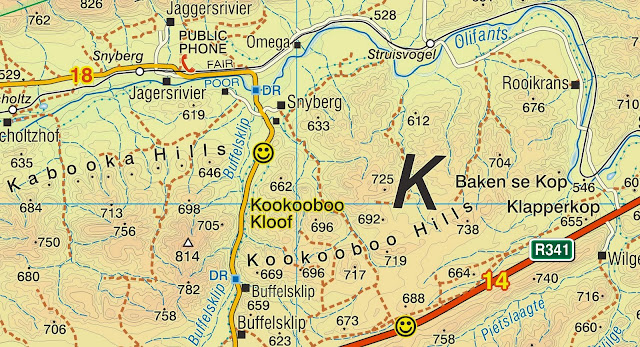Time to talk turtle. Well, tortoise, actually – I’ve never been able to understand why Americans lump all chelonians together as ‘turtles’. Turtles [and terrapins] live in water and are all carnivorous; tortoises bumble around on the land and they are, as far as I can tell, the only herbivorous reptiles left on Earth. [I have since been reliably informed that large lizards – leguaans, monitors etc. – have carnivorous young, but these mature into herbivores. —Ed]
 |
| Mr Foley, the largest leopard tortoise I have ever seen, lives at Sevilla in the Agter-Pakhuis. He might be vegetarian but he has a disturbingly hungry-looking way of following you around ... |
We have a tortoise in our garden. She’s always been there [she’s about 25 years old] and her name is Dink. We hoped for a long time that we might find a man-tortoise for her, and he was to be named ‘Humper’, after the singer most of us have forgotten – that Engelbert fellow. However, the best we could do for Dink was to borrow an extremely aggro and probably carnivorous male [tortoises, if fed enough meat, convert – rather like pigs].
This violent fellow had mad eyes and a vicious charge capable of knocking you off your feet. He was affectionately known as Mad Bob. I don’t think he was Zimbabwean but I am certain that he was, like his namesake, a closet gay. Mad Bob used to charge around the garden seeking anything that moved, or that he could move; he could roll a metre-long round pole from one end of the lawn to the other, head-butting it all the way.
 |
| This Yzerfontein tortoise closely resembles Mad Bob, but has much kinder eyes. |
Mad Bob was quite unable to impregnate Dink, even though he tried and tried and tried to mount her. She would merely walk away in search of dandelion leaves, and Mad Bob would slide off and land with a thump on the ground. Not very sexy.
We had to get rid of Mad Bob when he tried to mount the cat.
 |
| My brother sent me this pic that graphically illustrates what neither Mad Bob nor his namesake are probably capable of |
We think that Dink is probably quite a happy tortoise, though there is no way to tell, really. She wanders blissfully around the garden eating everything newly planted, especially small things with pretty flowers. She destroys groundcovers and gazanias in particular, but you can’t smack a naughty torty’s bottom. She’s not entirely untrainable, however – she’ll come to you if you call her by clicking your tongue, because she’s learned to associate the noise with red fruits, like strawberries. Every morning when we have breakfast on the stoep Dink arrives and begs at the edge of the grass, fixing us with her dark, beady eyes.
 |
| Dink enjoying a strawberry. It was her second for the morning and it defeated her in the end, but she returned later and polished it off. |
Dink has also learned – presumably the hard way – to avoid the grandchildren on their regular visits. Like our ancient dog, the Fat Dog of walkies fame, Dink only has to hear the wild cries of our angelic little girls, the crashing thunder of their twinkly little feet, and she’s off into the agapanthus. Agapanthus are good, because they also harbour large hairy spiders, the kind that twinkly little girls tend not to favour.
 |
| A friendly-looking torty from Baviaanskloof |
Kangaroos have large tails; they are essential for balance when hopping through the outback. Crocs use their tails for swimming and knocking prey about. Hippos have tails like fans, that they use for spraying their faeces all over the place; porcupines have short, hard spines on their tails with which to club their enemies. Dogs have tails for balance when they run, and for wagging at their owners, and these days it’s illegal to dock them. Horses have tails as fly-whisks ... the list goes on and on. And on.
But why do tortoises have tails? Every tortoise has a vestigial little tail that has absolutely no use at all. Like stomach-appendixes and male nipples, tortoises’ tails are an unanswerable argument against so-called ‘intelligent design’. Not only are tortoises’ tails quite useless, they also look amazingly stupid ...
I guess you could take this further and ask why a ‘creator’ gave torties tails, but if you are an evolutionist you’ll be completely easy with the explanation that their tails used to be long, large and useful for swimming ... as the fossil record, indeed, shows.
Speaking of which, I discovered something really interesting the other day. A long time ago a loopy cleric known as Bishop Usher ‘worked out’ in a fit of mathematical inexactitude that the Earth was created in 4004 BC. What I discovered was that this antediluvian nutcase also claimed that the date of this fundamental event was the 22nd of October. My birthday! Hooray! I was born on Creation Day! Isn’t that great?
Then I stopped and thought, if the unfortunate Bishop was right, as countless millions of deluded people (especially 60% of Americans) appear to believe, why is my birthday not a world-wide public holiday? Surely there could be no more important day of the year, even more important than Christmas, than Creation Day, the day it all began?
 |
| A large and rather boring torty who terrorizes small children at Helderberg Nature Reserve |
Which is a pity – be really nice if my birthday was always a holiday.
Tortoises and all that have only a passing link to maps – in Afrikaans their name is skilpad, or ‘shell road’. Don’t ask me why, but maps also have roads, so there it is. Happy New Year!
Kaartman, Summer Solstice, 2011



































